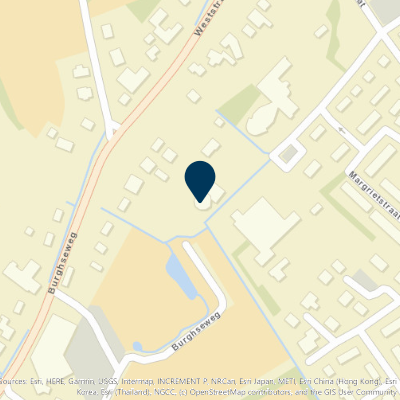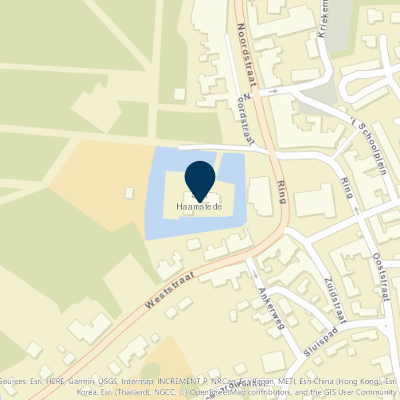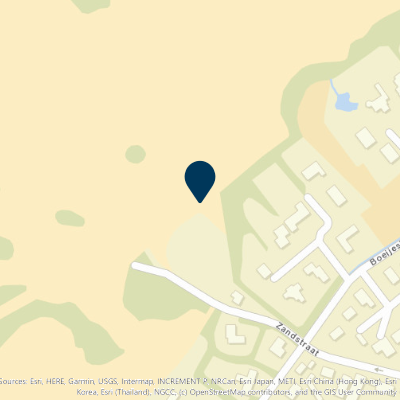Pearl Route Protection - Zeepeduinen, Burgh-Haamstede
Zeeland is like a large oyster with many beautiful pearls. With this puzzle route, you will discover the hidden treasures of Burgh-Haamstede and its surroundings. Sometimes they are so well hidden that you can only find them by looking closely.
Start location: Leliëndaleweg 3, 4328 LD Burgh-Haamstede
How does it work?
Follow the route by clicking on 'Map' in t…
Zeeland is like a large oyster with many beautiful pearls. With this puzzle route, you will discover the hidden treasures of Burgh-Haamstede and its surroundings. Sometimes they are so well hidden that you can only find them by looking closely.
Start location: Leliëndaleweg 3, 4328 LD Burgh-Haamstede
How does it work?
Follow the route by clicking on 'Map' in the bottom right of your screen. Then zoom in on the start (number 1) and press the numbered points to discover more about the area. Behind some numbers, there are audio fragments and, among other things, questions. Answer the questions and collect letters. At the end of the route, you can form a sentence of 3 words with these letters.
Take a look
Sights on this route
Starting point:
Leliëndaleweg 34328LD Burgh-Haamstede
Starting point
Leliëndaleweg 3
4328LD Burgh-Haamstede
LISTEN: Intro to the Zeepeduinen
In this listening walk, discover the hidden treasures of Burgh-Haamstede and its surroundings.
LISTEN: Intro to the Zeepeduinen
In this listening walk, discover the hidden treasures of Burgh-Haamstede and its surroundings.

LISTEN: Intro to the Zeepeduinen
In this listening walk, discover the hidden treasures of Burgh-Haamstede and its surroundings.

QUESTION: Ringwalburg
The Carolingian castle, also known as the Ringwalburg, is an impressive historical defensive structure from the late 9th century.
QUESTION: Ringwalburg
The Ringwalburg offered protection from the Vikings.
Question 1: Which place did the rampart protect here? Take the last letter of the answer.

QUESTION: Ringwalburg
The Carolingian castle, also known as the Ringwalburg, is an impressive historical defensive structure from the late 9th century.

QUESTION: Mill de Graanhalm
Mill de Graanhalm in Burgh-Haamstede is a unique 1847 corn-wood sawmill.
QUESTION: Mill de Graanhalm
Mill de Graanhalm (1847) is a corn-wood sawmill. It used to be exclusively a corn mill, but in 2003 a saw was installed at the bottom of the mill. This can saw whole logs with the help of wind or motor power. At the top of the mill, stone Zeeland flail wheat is ground into wholemeal flour. Next to the mill, you will find a pancake house with more than 30 different kinds of pancakes. Whole wheat pancakes are served from Zeeland Vlegel wheat. Environmentally friendly wheat grown in the region and milled at the mill.
Question 2: When was the first pancake baked in this mill?Take the 3rd letter of the month.

QUESTION: Mill de Graanhalm
Mill de Graanhalm in Burgh-Haamstede is a unique 1847 corn-wood sawmill.
Question: Slot
Discover this ancient castle: an old castle with moat, surrounded by a castle forest and adjacent dune area.
Question: Slot
Which castle can you see along the way?
Question 3: Take the last letter of the answer.

Question: Slot
Discover this ancient castle: an old castle with moat, surrounded by a castle forest and adjacent dune area.
LISTEN & QUESTION: Whale bunker
Listen to how the Whale bunker is part of the Atlantic Wall.
LISTEN & QUESTION: Whale bunker
World War II. The German occupying forces want to protect themselves from the Allies. They build a wall of bunkers along the coast of Europe, the Atlantic Wall. This whale bunker is also part of it. It is located on top of a dune and for good reason. From this bunker the Germans commanded all the defences on Schouwen. Inside the bunker are rooms for radio, officers, supplies and a machine gun post for the defence of the bunker itself. On the roof you can still see the armoured observation turret.
Question 5: What is the German name of the bunker complex that stood here? Take the 4th letter of the answer.
Question 6: In the bunker you will find protected animals. Which animal is indicated in the picture? Take the 2nd letter of the answer

LISTEN & QUESTION: Whale bunker
Listen to how the Whale bunker is part of the Atlantic Wall.

LISTEN & QUESTION: Zeepeduinen
In this listening clip, you will hear more about the Zeepeduinen and where the dunes got their name from.
LISTEN & QUESTION: Zeepeduinen
The Zeepeduinen. Why is this area actually called that? What does soap have to do with it? Nothing at all. Zeepe comes from the Zeeland word sepelen, meaning seep. Groundwater seeps here from the dunes to the lower surroundings. There used to be many wet dune valleys, or dune lakes, but they have grown over time. Of four valleys, the top layer has been excavated, so that there is water in them again. There are marshy clearings with creeping willow, centaury, parnassia and field rush. You can now find natterjack toads, green frogs and newts.
Question 4: Which beautiful white-yellow flower grows in the Sea Dunes? Take the 3rd letter of the answer.

LISTEN & QUESTION: Zeepeduinen
In this listening clip, you will hear more about the Zeepeduinen and where the dunes got their name from.

LISTEN & QUESTION: Animal Noise
Listen very carefully to the animal sounds you hear here.
LISTEN & QUESTION: Animal Noise
Be very quiet. What do you hear? You might hear mallards, table ducks and shelducks quacking in the lakes. Or you might hear the plaintive call of the curlew and the song of the woodlark. Perhaps the tapping of the green woodpecker. The rustling of a lizard in the bushes or a creaking branch when a roe deer or fallow deer is on it. So, as you can see, it can be quite busy in the Sea Dunes. And if that is not enough, a few kilometres away is a gull breeding colony. So look and listen carefully, maybe the animals will show themselves.
Question 7: You will find several species of ducks here: the mallard and the shelduck. Which ones more? Take the first letter of the answer.

LISTEN & QUESTION: Animal Noise
Listen very carefully to the animal sounds you hear here.

Problem Pearl Route Protection
In this listening clip, you will hear more about the problem that was going on in the Zeepeduinen.
Problem Pearl Route Protection
Local farmers used to let their cattle graze in this area. The lord of Haamstede Castle paid them for this. By kicking their hooves and grazing, you got a lot of different plants in the landscape. From the 1960s, farmers focused on tourists and the grazers disappeared. The dune grasslands became quite overgrown, but with many of the same plants and trees. Then the rabbits also got sick, so they too disappeared from the dunes. Lots of the same plants, means fewer animals. A big problem that had to be solved. Imagine you are a protector of the Sea Dunes. How would you solve it?

Problem Pearl Route Protection
In this listening clip, you will hear more about the problem that was going on in the Zeepeduinen.
LISTEN & QUESTION: Handy gardeners
In this listening clip, you'll hear all about the Shetland ponies that protect the dunes.
LISTEN & QUESTION: Handy gardeners
You can see very far here, not everything is overgrown. You see dune grassland, drifting sand and dune valleys. This is very rare in the Netherlands. To make sure it stays open, around 100 Shetland ponies walk around here. They eat dune reeds, saplings and tree bark. They also break up the soil. This allows the sand to be carried away by the wind, creating new sand dunes. Sand bees and sand beetles live in the sand and “sand plants” such as marram grass and sand seagrass grow there. This is how they protect the Sea Dunes from becoming overgrown. Handy gardeners, those Shetland ponies.
Take the 6th and 8th letters of these handy gardeners.

LISTEN & QUESTION: Handy gardeners
In this listening clip, you'll hear all about the Shetland ponies that protect the dunes.
End of Pearl Route Protection
You have now arrived at the end of the route.
End of Pearl Route Protection
You have now found a sentence. You will find this phrase during your route. So keep looking around! Have you found the pearl? Then keep looking. The pearls are scattered all over Zeeland! Search and find them all!
Didn't manage to find all the letters or do you want to know the right answers? Then check out the answers here.

End of Pearl Route Protection
You have now arrived at the end of the route.
End point:
Burgh-HaamstedeEnd point
Burgh-Haamstede
Directions
Starting point:
Leliëndaleweg 34328LD Burgh-Haamstede
-
Ringburgwal (Ring Dike) The ring dike offered protection against the Vikings. Question 1: Which place did the dike protect here? Take the last letter of the answer.
-
Pannenkoekenmolen (Pancake Mill) Molen de Graanhalm (1847) is a grain and wood sawing mill. It used to be exclusively a grain mill, but in 2003 a saw was installed downstairs in the mill. This can saw entire tree trunks with the help of wind or engine power. Upstairs in the mill, Zeeuwse vlegel wheat is ground into whole wheat flour with stones. Next to the mill, you will find a pancake house with more than 30 different types of pancakes. Whole wheat pancakes made from Zeeuwse Vlegel wheat are served. Environmentally friendly grown wheat from the region that is ground in the mill. Question 2: When was the first pancake baked in this mill? Take the 3rd letter of the month.
-
Slot (Castle) Which castle can you see along the way? Question 3: Take the last letter of the answer.
-
Zeepeduinen (Seepage Dunes) The Zeepeduinen. Why is this area actually called that? What does soap have to do with it? Nothing at all. Zeepe comes from the Zeelandic word 'sepelen', which means to seep. The groundwater seeps here from the dunes to the lower-lying area. In the past, there were many wet dune valleys, or dune lakes, but these have become overgrown over time. The top layer of four valleys has been excavated so that there is water in them again. There are marshy open areas with creeping willow, centaury, parnassia, and field rush. You can now find natterjacks, green frogs, and newts there. Question 4: Which beautiful white-yellow flower grows in the Zeepeduinen? Take the 3rd letter of the answer.
-
Bunkers The Second World War. The German occupier wants to protect themselves against the Allies. They build a wall of bunkers along the coast of Europe, the Atlantic Wall. This whale bunker is also part of it. It is located on top of a dune, and that is no coincidence. From this bunker, the Germans commanded all the defenses on Schouwen. Inside the bunker, there are rooms for radio, officers, supplies, and a machine gun post for the defense of the bunker itself. On the roof, you can still see the armored observation dome. Question 5: What is the German name of the bunker complex that stood here? Take the 4th letter of the answer.
Question 6: You will find protected animals in the bunker. Which animal is indicated in the picture? Take the 2nd letter of the answer.
Animal Activity Be very quiet. What do you hear? You might hear mallards, pochards, and scaups quacking in the lakes. Or you might hear the mournful call of the curlew and the song of the woodlark. Maybe even the drumming of the green woodpecker. The rustling of a lizard in the undergrowth or a cracking twig when a roe deer or fallow deer steps on it. As you can see, it can be quite busy in the Zeepeduinen. And if that's not enough, a few kilometers further on is a gull breeding colony. So watch and listen carefully, maybe the animals will show themselves. Question 7: You will find different types of ducks here: the mallard and the scaup. Which other one? Take the first letter of the answer.
Handy Gardeners You can see very far here; not everything is overgrown. You see dune grassland, drifting sand, and dune valleys. That is very rare in the Netherlands. To ensure that it remains open, about 100 Shetland ponies roam here. They eat dune reed, young trees, and tree bark. They also trample the ground. This allows the wind to carry away the sand, and new sand dunes can form again. Sand bees and sand beetles live in the sand, and 'sand plants' such as marram grass and sand sedge grow there. This is how they protect the Zeepeduinen from overgrowth. Handy gardeners, those Shetland ponies.
Take the 6th and 8th letter of these handy gardeners.
These were all the questions. If you have done well, you can now form a sentence of 3 words.
End point:
Burgh-Haamstede- 43
- 42
- 41
- 48
- 45
- 44








